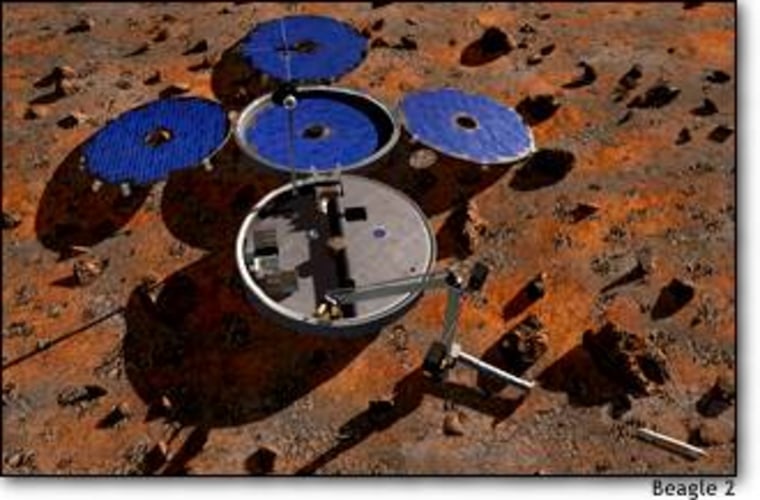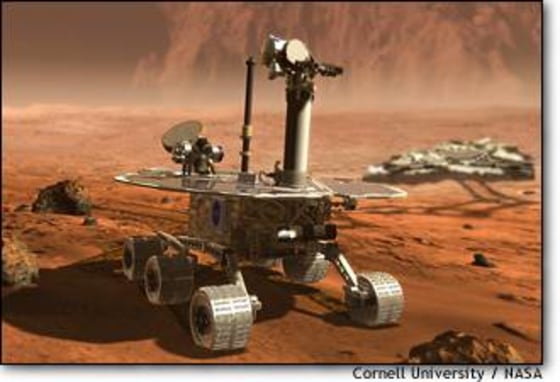The first of two NASA Mars surface rovers launched Tuesday afternoon from Cape Canaveral in Florida. Here are some frequently asked questions about the launch and mission.
When is the launch?
The first spacecraft, MER-A, now christened “Spirit”, took off for Mars on Tuesday, June 10, after two days of weather delays. The MER-B launch window opens June 25.
How can I watch the launch?
The launch will be streamed live over the Internet on NASA TV, which is available via many Web sites, including Space.com and MSNBC.com.
If you’ll be in Florida, you can call the KSC Visitor Complex at (321) 449-4444 for information on purchasing tickets (if any are available) to watch up close. More information is here.
What will happen during launch?
The rover package will be lofted into space aboard a Delta 2 rocket. This same rocket family was used for Mars Global Surveyor and Mars Pathfinder in 1996, Mars Climate Orbiter in 1998 (which missed Mars), Mars Polar Lander in 1999 (which failed during landing), and Mars Odyssey in 2001 (Whew! Currently orbiting Mars).
The general idea is to go up. Just 32.4 seconds after launch, the rocket and payload will break the sound barrier. After reaching space, the setup will go into a circular “parking orbit” where it all coasts for awhile. Then another rocket burn will send the craft toward Mars. The robot and the rocket separate about 39 minutes after launch. From NASA: Detailed timetable.
What are the rovers’ names?
NASA Chief Administrator Sean O’Keefe announced Sunday that the Mars Exploration Rovers had been renamed Spirit and Opportunity.
O’Keefe made the announcement at a press conference along with Sofi Collis, the 9-year-old who had submitted the winning names in a contest sponsored by The Planetary Society and LEGO. Collis, a third-grader from Scottsdale, Arizona, was born in Siberia and had been adopted by an America family at the age two. Her submissions were selected from 10,000 entries.
Speculation for the names had included Orville and Wilbur (Wright, because of the 100th anniversary of their flight), or Marvin the Martian and Daffy Duck. The names that were chosen, however, are more reminiscent of landers past; recall the Sojourner rover of the 1997 Pathfinder mission. Then before that there was Viking 1 and Viking 2.
Why are there two rovers?
Well, it’s good insurance in case one blows up, crashes, or simply fails to phone home. But scientifically, a pair will be much more effective because each will study geologically different regions of Mars. Check out the landing sites.
Will the rovers travel naked through space?
Not at all. Each rover is folded up inside a protective shell. The shell separates from the rocket after its all headed Marsward.
The spacecraft is able to maneuver as it approaches and enters the Martian atmosphere. Its most noticeable component is an aeroshell, which protects the rover from the heat of entry. It also packs a parachute and the airbags that the rover will be inside as it bounces about a dozen times before coming to rest, somewhere.
Then, if all goes well, the spacecraft lowers a ramp and the rover drives out.
When do the NASA rovers get to Mars?
The first rover should arrive at Mars on Jan. 4, 2004. The second one gets there Jan. 25.
What will the rovers do?
First, they’ll rove. Each one can travel up to the length of a football field every day. Never has a Mars craft been so mobile. Each rover carries a panoramic camera and a nifty set of geologist’s tools.
The rovers will photograph rocks, and scientists back home will decide which rocks to dig into. The rovers carry a RAT (Rock Abrasion Tool) that can dig into a rock so its chemical contents can be sampled.
Is there a European lander on its way, too?
Yes. On June 2, the European Space Agency launched Mars Express. It carries a landing craft called Beagle 2 (“Beagle 1” was the HMS Beagle, a ship Charles Darwin sailed aboard when figuring out evolution).
Beagle 2 can’t rove, and it has no RAT, but it has a cool “mole” that’s attached by cable and can go out 8-10 feet, dig around, and then be winched back in.
The mother craft, orbiting Mars, will bounce radar off the planet in search for hidden pools of water deep underground. Project scientists call the setup the most effective tool ever sent to look for signs of Martian biology.

Is this a race?
Scientists don’t like to paint it that way, but it’s hard to imagine that they aren’t competing. If you ran NASA’s Mars program, would you want your mission to be the first one or the second one to find firm signs of liquid water on Mars?
The European Mars Express will have the first opportunity to make a discovery. It arrives at Mars Dec. 24, about two weeks before NASA’s first rover is due.
Is there water on Mars?
Maybe. But so far scientists have found only frozen water — and there appears to be lots of it. Liquid water, however, is what they really want to find, because it is a necessary requirement for life as we know it.
Is there life on Mars?
That’s the biggest question in space science, many researchers would agree. And nobody knows the answer.
There is an outside chance one of the new trio of Mars surface robots will find signs of life, present or (more likely) past.
We at Space.com are excited about the possibility, but we’re not holding our collective breath. NASA scientists play down the possibility of finding life’s signatures at Mars with the current missions.
Many researchers figure the rovers will make necessary discoveries about Mars that will lay the groundwork for future missions more focused on uncovering any possible biology. Some geologists believe that we’ll need to send humans to Mars to learn the answer.
Can I see Mars?
Sure! You can’t miss it right now in the predawn sky, toward the southeast. And Mars is growing larger and brighter every morning, headed toward the best viewing opportunity in human history this August.
